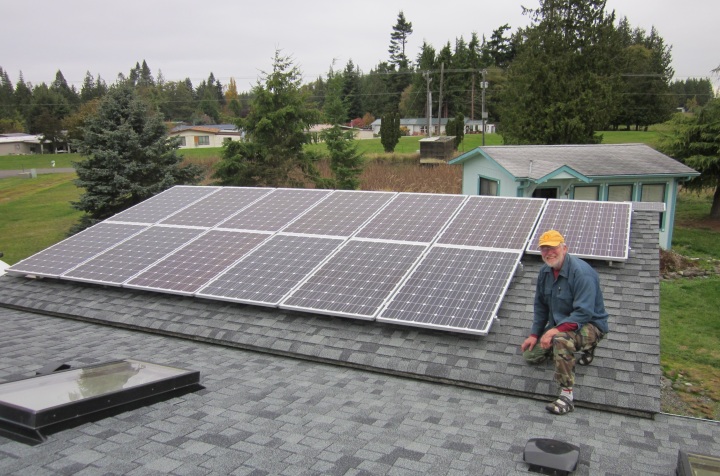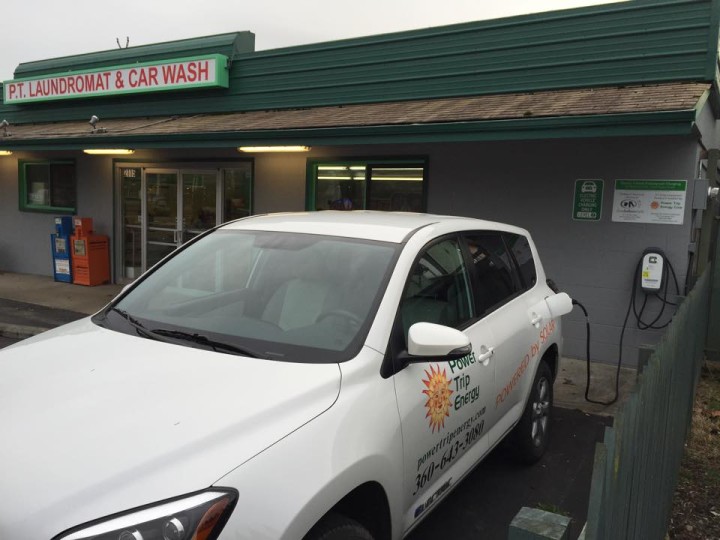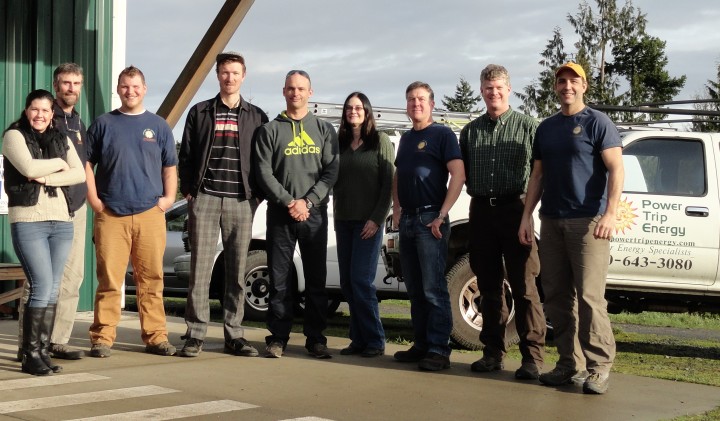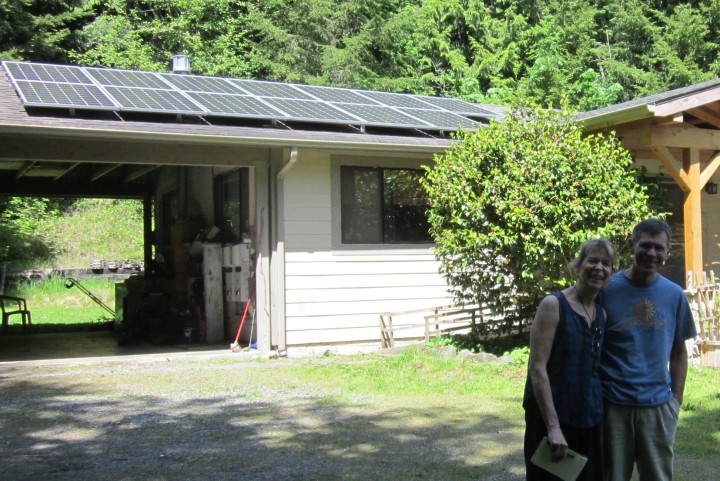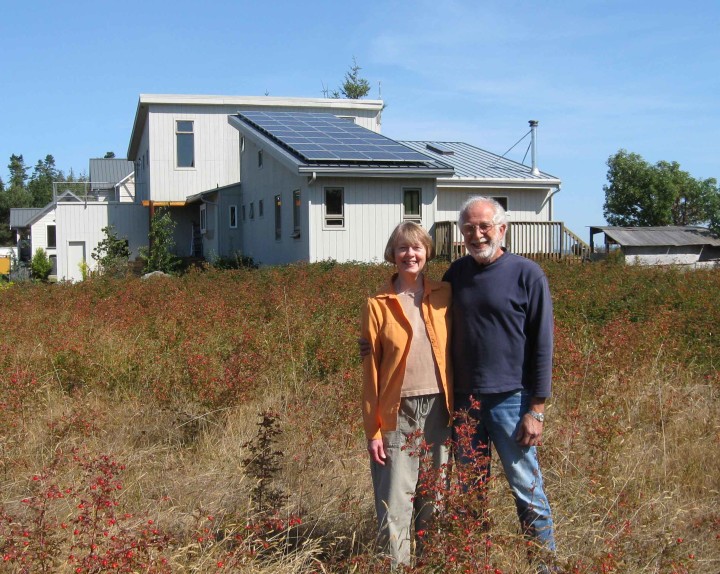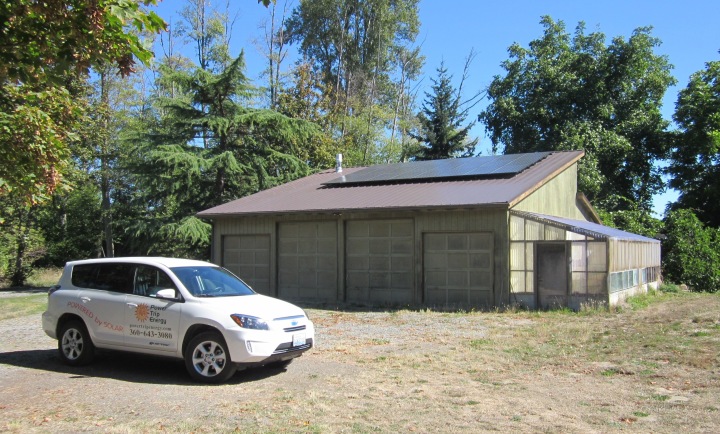Net Metering Primer Describes Current & Future Models of Net Energy Metering for Solar
Tobin Booth provides a good primer on Net Metering in the article linked below. We have a strong foundation here in Washington with our state laws, but our 1998-era Net Metering Law is hamstrung with caps that are too restrictive. Who would have ever imagined that one day we would have solar capacity of 0.5% of our peak loads ?!? Now that we have reached this amount in a few utility territories, we are faced with reactionary policy efforts from old-school utility execs in Olympia fearful for their revenues.
Unfortunately, instead of working together to envision how we could enact virtual net metering, we are combating various utility proposals to roll back progress and assign unrealistic and unnecessary costs to new Net Metering Customers who want to install solar.
Clallam PUD’s drafted new interconnection standards
There are some new rules proposed by Clallam PUD that will affect our clients who wish to install grid-tied solar pv systems. Some of the proposed rules would add expense, complexity, and uncertainty – we feel needlessly.
Here are the proposed rules:
Interconnection Requirements_Draft_2014-11-18-3
and our comments:
Power Trip EV Tourism Initiative – Part II – Jefferson County Chamber presentation
Yesterday we had the opportunity to speak to the Jefferson Chamber of Commerce about our EV Tourism Initiative, which was fun. Thanks for inviting us!
We are making that presentation available here:
Power Trip EV Tourism Initiative
We have completed installation of the first two of five publicly available Level II EV charging stations in Port Townsend.
The currently on-line locations are at The Northwest Maritime Center on Water Street and the PT Laundromat and Car Wash on upper Sims Way.
The imminent locations are Windermere Realty on Water Street, and at John L Scott Real Estate and at GreenPod Development at Synergy Station on Upper Sims Way.
The charging stations were each donated by Power Trip Energy. The business owners are paying for some installation expenses and have committed to giving away the electricity people use to charge their vehicles, predominantly to customers and tourists.
The two free Level II chargers at our shop in Glen Cove are well-used by people from out of town despite the inconvenient location. The 10 kilowatt pv arrays at our shop produce more than 100% of the electricity we consume, even including giving as much away as possible to charge electric vehicles.
We know EV registrations per capita are among the highest in the nation here in Western Washington. A large amount of the tourists who visit Port Townsend are from metropolitan areas within 100 miles. The Nissan Leaf has a range of about 70 miles so can reach here from Seattle, but not make a return trip without recharging. The Tesla has an approximate 200 mile range.
The stations available here in Port Townsend will be publicized through PlugShare.com, a website and phone mobile app with maps of charging locations, and the various Seattle EV owners’ online groups. We are hoping that the Jefferson Chamber of Commerce and Local 2020 will assist with the publicity and documentation of usage.
There will be paper surveys at the charging sites and that information will be collected which will help determine what are the economic impacts to the community from the visitors who use the stations.
We envision that if the first wave of installations become heavily used, a second phase of installations will perhaps paid be for by a cabal of businesses that benefit from the visitors but don’t have a parking spot.
The PT EV Tourism initiative will be the topic for the Jefferson Chamber of Commerce Luncheon Monday, January 26 at 12 pm, at the Elks Lodge, 555 Otto St, Port Townsend.
2014 in Review – 2015 Forecast
It was a very good year for solar at Power Trip Energy, across the state, and nationwide. Statewide, about 11.2 MW of pv was installed, which represents in increase in capacity of about 45% over the previous year, which showed an increase of 70% over the year before that. At this point, the Washington cost recovery program payments (that incentivize grid-tied solar pv) totaled about $5 million in 2014.
Locally we installed 68 grid-tied pv projects totalling 484 KW – an increase of 26% in terms of KW over the previous year. In terms of the brands of pv we installed, 60% was SunPower, 35% was SolarWorld, and about 5% was “Made in Washington”.
Nationally, we are seeing results showing a 40% increase over the previous year. Every state is different in terms of energy policy, electricity pricing, and incentives, so it is difficult to make broad statements, and when you do see a broad statement made by others – be very skeptical until you’ve seen the underlying data.
In terms of performance, last year cooperated with a good spring and good summer. Most of our systems performed at about 10% over the average, and many of the SunPower systems performed at 20-25% over our performance estimates. We may have to alter our modeling for the SunPower systems performance estimates.
In addition to installing a record amount of pv, we installed 6 Level II EV chargers for our clients. Several of those clients are making over 50% of their own electricity including replacing gasoline with electricity as their source of energy for personal transportation.
In 2014 we continued to see slight price decreases and slight efficiency increases. We became more stringent on our quality control standards and pretty much limited our offerings to SunPower and SolarWorld in terms of module manufacturers, forgoing offering the Made in WA pv modules. As we keep an eye on the state of the industry and introduction of new products, we retain the primary goal of using the highest quality equipment from the most reliable manufacturers as the best way to ensure long-term value for our clients.
Here at our shop, we increase the capacity of our solar arrays from 4 KW to 10 KW by adding 6 KW of Solar World modules. We also added a second Level II EV charger in response to the increased usage of our free EV charging stations available to anybody, any time.
We are looking to accommodate more growth in 2015 by adding 1-3 more people if everything goes according to plan. Last year we added two new people – Patrick – a new installer and electrical trainee, and Dierdre – a new marketing assistant. Also, after taking one year off due to market chaos, we have been able to re-implement our company group health insurance plan.
Looking ahead to 2015, we are seeing continued growing interest, and we feel it is likely next year will be another high water mark. In addition to our period Spin Your Meter Backwards presentations in various locations, we will be organizing several solar tours this year. We have been sponsors of the Jefferson Energy Lunch series since its inception, and we are commencing a new Power Lunch Kitsap series in conjunction with Rice Fergus Miller Architects in downtown Bremerton. We are also currently installing 5 public Level II EV chargers here in Port Townsend as the first phase of our Power Trip Energy EV Tourism initiative. Look for more details on this by the end of the month, once installations are complete, and inspections finaled.
The existing state of the market is amazing in terms of the lowest prices and highest quality equipment we have ever seen, combined with several incentive programs in place for another couple of years: the 30% Federal tax credit (until 2016), the Washington State sales tax exemption (until 2018), and the annual production incentive payments available through the Washington State Renewable Energy Cost Recovery Program (in place until 2020.) There has never been a better time to install solar, and depending on whether those incentives are extended, we may not see a moment like this again. If you have been considering installing grid-tied pv, give us a call or learn more at https://powertripenergy.com
Solar Installations in US up 41% in Q-3 compared to a year ago
The third quarter of this year was a high water mark for us, and our success matches the nation-wide trend. For our part, in our little corner of the world, we installed 168 KW of residential pv in the third quarter. This is equal to the amount of pv we installed in our first 4-1/2 years, from 2003 through the first half of 2007.
Nation-wide, over 300 MW of residential pv was installed in Q-3, and over 1.3 GW was installed in total, when counting the larger commercial and utility projects that came on-line.
Thanks to SEIA for keeping track!
Solar Windows – Again
Solar Windows – Again
I’ve been seeing solar window ideas for years and I am skeptical about their practicality. Check this recent article for more info http://www.extremetech.com/extreme/188667-a-fully-transparent-solar-cell-that-could-make-every-window-and-screen-a-power-source (Thank you Deanna for bringing this article to my attention.)
I’m surely open to new ideas, but here are some of the challenges I see with this idea:
1. I always wonder about wiring all the windows together and getting that electricity to the electrical service panel. It is obviously not a casual retrofit, so maybe just applicable to new construction. There are other electrical challenges that could be addressed by standardizing size and shape of the window pv modules, but possibly at the cost of some aesthetics if everybody’s home begins to have identical windows. That is not my biggest worry though.
2. They are claiming 1% efficiency currently and hoping to quintuple that to 5% eventually with this product. The leading SunPower pv modules we are installing currently are in the 20-22% efficiency range, meaning for every 1000 watts of light energy that hits the pv module, they generate about 200 watts. We are usually using the highest efficiency modules we can get because we are striving to make as much energy as possible per installation.
3. Even using the highest efficiency modules we can get, we are often limited by available roof space and can’t make as much energy as we would like. There is much less window area compared to roof area. The roof, being highest, is generally the sunniest portion of the building.
4. Windows are basically holes in our insulated buildings; even the highest tech triple pane Argon-filled windows are major heat losers here in the PNW. I wouldn’t want to see people increasing window sizes and decreasing the insulation value of the building’s envelope in order to make more electricity – that would be going backwards fast overall. And in the summer, having too much south-facing glass is the best way to require air conditioning, a huge energy load that should be unnecessary in PNW homes.
After 12 years installing pv, and seeing so many new solar innovations announced without coming to fruition, I have become convinced that until we put standard pv modules (currently available and fairly inexpensive) on every sunny roof, products like solar windows are solving a problem that does not exist.
SunPower and SolarWorld Both Ranked in Top 5 in Study of Environmental Aspects of PV Manufacturing
The Silicon Valley Toxics Coalition is renowned for conducting in-depth studies regarding the environmental and labor policy aspects of high tech manufacturers. In this year’s study of the top solar PV manufacturers, SunPower has ranked #2, and SolarWorld has ranked #4. We are proud to be SunPower Preferred Dealers and members of SolarWorld’s Authorized Dealer Network. Also of note, SunPower was recently the first pv manufacturer to receive certification from the Cradle to Cradle Products Innovation Institute which I wrote about recently. https://powertripenergy.com/sunpower-achieves-cradle-to-cradle-product-certification/
Congratulations are in order for top-ranked Trina, and #3 rated Yingli – both top Chinese manufacturers. While we are not currently offering Chinese manufactured products, we respect these company’s commitment to environmental cleanliness despite the lack of environmental regulations in their country of origin. Norway’s REC, with a major presense in Moses Lake, WA, rounds out the top 5. Of note, all five members of the Top 5 are dedicated PV manufacturing companies, focusing entirely on one product, and bringing a philosophy of vertical integration to their process. This may indicate that the mindset and ethic of the corporate leadership has a holistic understanding of the whys behind the hows of solar.
Shame to Panasonic, Sharp, Samsung, and Hyundai – all major electronics manufacturers and major PV manufacturers on the global market who all scored near the bottom of the list. Get with the program!
What is the environmental score of your pv array? Read the full report at the link below, and heed the advice of the authors: “Use this scorecard to help choose a manufacturer that is committed to high environmental and worker safety standards for PV module manufacturing.” Hint: if you don’t know who made your cells, that may not be good.
Recognizing Net Metering is Unstoppable, Utilities Try to Raise Monthly Base Charges
Pacific Power (wholly owned subsidiary of Berkshire Hathaway Energy) proposed to nearly double the monthly fixed charge to residential customers, from $7.75 to $14/month. Washington’s AG recommends denial to the UTC. http://www.dailysunnews.com/news/2014/oct/21/states-attorney-general-challenges-rate-increase-p/
Fixed rate charges are “the biggest threat to energy efficiency and clean energy the U.S. faces.” – Jim Lazar, Sr. Advisor, Regulatory Assistance Project.
The attached article below is a review of several utility efforts across the country to either raise special monthly charges on net metering customers, or everybody. These efforts became widespread as a result of the Edison Electric Institute’s recent paper on “Disruptive Challenges” calling attention to what has been affectionately dubbed “The Utility Death Spiral.” While rumors of Utility Death Spiral may be premature, efforts to undermine your ability to benefit from personal renewable energy adoption are real.
http://www.utilitydive.com/news/the-fight-over-solar-moves-from-net-metering-to-rate-design/327742/
Net Metering Limits – What is Reasonable?
I recently came across this interesting info-graphic. It is a couple of years old now and does not apply to Washington State. It mentions how different states look at determining a reasonable amount of power generation that can come from net metered solar, and uses examples of 15%, 25% (Hawaii), or 50% (California) and different thresholds to use as a basis for those percentages.
Here in Washington State, utilities are only required to allow 0.5% of the 1996 peak load – such a low threshold it is ridiculously limiting. Thankfully the utilities in which we have surpassed this threshold have seen no problems with allowing additional net metering systems. In the coming months we will be working closely with our legislators to address this archaic and potentially stifling limitation before it negatively affects our clients and our community.
Enjoy this explanatory graphic:
http://ilsr.org/archiac-utility-rules-stall-local-solar-infographic/
Another beautiful ground mounted array for beautiful people in Poulsbo, October 2014.
